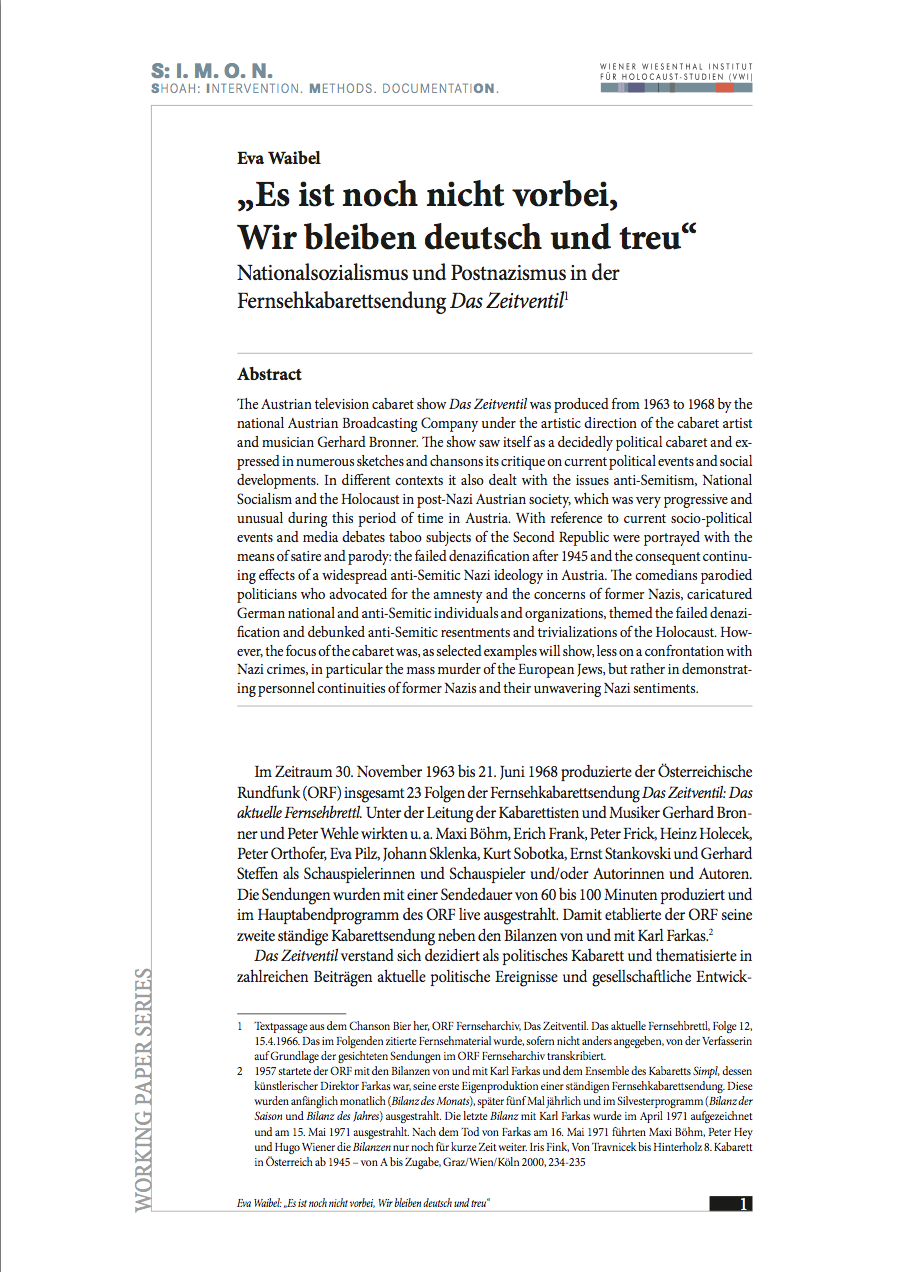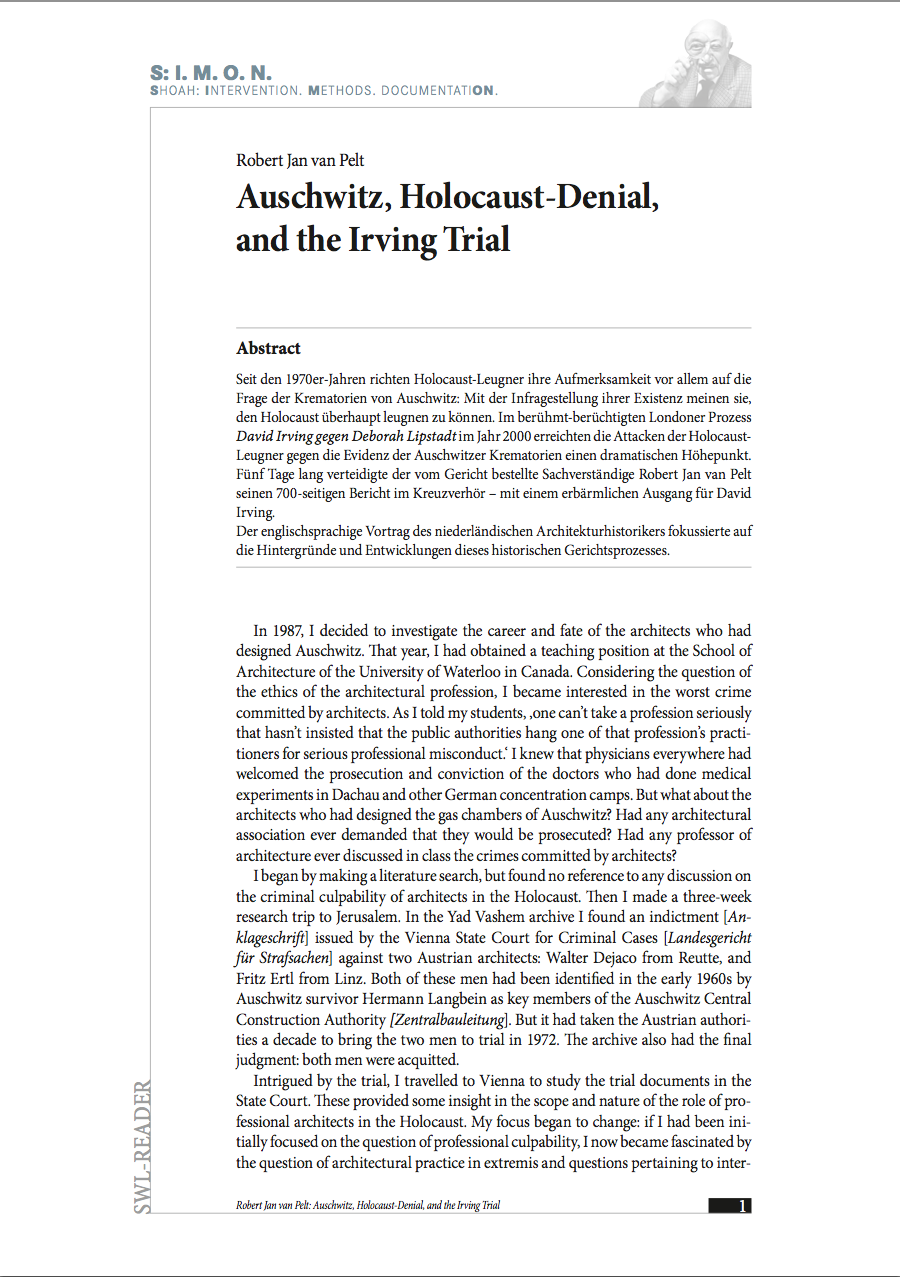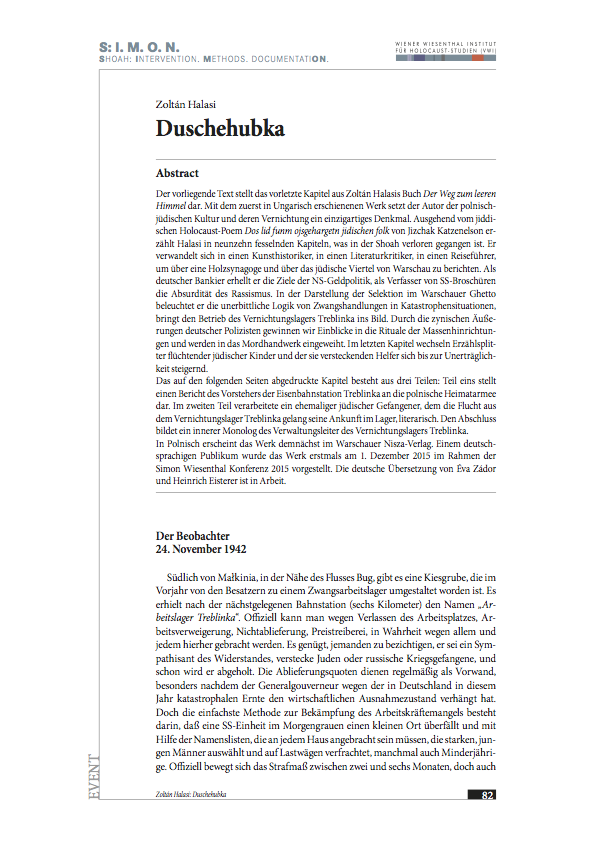 Rostov-on-Don is known for being the site of the largest massacre during the Holocaust in contemporary Russia and witnessed the annihilation of Soviet Russia’s third-largest pre-war Jewish community within only a few days. It is considered the Russian Babi Yar by some Russian historians. Yet, outside of Russia, the city’s tragic past is hardly known. In August 1942, a massacre was committed here by Sonderkommando 10a of Einsatzgruppe D. The numbers of victims of the mass atrocity diverge in the literature, in some cases considerably. A conservative estimate is that 15,000–18,000 Jewish men, women, and children were murdered within only three days on the outskirts of Rostov, near the Zmievka colony. Some scholars speak of even higher victim numbers. Nevertheless, the atrocity has not received much scholarly attention. The events in Rostov are but one example of the escalation that Hitler’s Judenpolitik had undergone between the beginning of ‘Operation Barbarossa’ on 22 June 1941 and the summer of 1942. It illustrates that it is vital to bring together all existing sources, including perpetrator documents, records of post-war trials, as well as Soviet files, because a one-sided focus on perpetrator documents in previous Western studies on Rostov does not allow for a full understanding of the scale and the course of events, as this article aims to demonstrate.
Rostov-on-Don is known for being the site of the largest massacre during the Holocaust in contemporary Russia and witnessed the annihilation of Soviet Russia’s third-largest pre-war Jewish community within only a few days. It is considered the Russian Babi Yar by some Russian historians. Yet, outside of Russia, the city’s tragic past is hardly known. In August 1942, a massacre was committed here by Sonderkommando 10a of Einsatzgruppe D. The numbers of victims of the mass atrocity diverge in the literature, in some cases considerably. A conservative estimate is that 15,000–18,000 Jewish men, women, and children were murdered within only three days on the outskirts of Rostov, near the Zmievka colony. Some scholars speak of even higher victim numbers. Nevertheless, the atrocity has not received much scholarly attention. The events in Rostov are but one example of the escalation that Hitler’s Judenpolitik had undergone between the beginning of ‘Operation Barbarossa’ on 22 June 1941 and the summer of 1942. It illustrates that it is vital to bring together all existing sources, including perpetrator documents, records of post-war trials, as well as Soviet files, because a one-sided focus on perpetrator documents in previous Western studies on Rostov does not allow for a full understanding of the scale and the course of events, as this article aims to demonstrate.
Editorial
 S:I.M.O.N. is an e-journal of the Vienna Wiesenthal Institute for Holocaust Studies (VWI). It appears twice a year in English and German language. S:I.M.O.N. aims at both a transnational and comparative history of the Holocaust and Jewish Studies in Central and Eastern Europe within the broader contexts of the European history of the 20th and 21st century, including its prehistory, consequences and legacies as well as the history of memory.
S:I.M.O.N. is an e-journal of the Vienna Wiesenthal Institute for Holocaust Studies (VWI). It appears twice a year in English and German language. S:I.M.O.N. aims at both a transnational and comparative history of the Holocaust and Jewish Studies in Central and Eastern Europe within the broader contexts of the European history of the 20th and 21st century, including its prehistory, consequences and legacies as well as the history of memory.
S:I.M.O.N. serves as a forum for discussion of various methodological approaches. The journal especially wishes to strengthen the exchange between researchers from different scientific communities and to integrate both the Jewish history and the history of the Holocaust into the different “national” narratives. It also lays a special emphasis on memory studies and the analysis of politics of memory. S:I.M.O.N. uses a double-blind review system, which means that both the reviewer’s and the author’s identities are concealed from each other hroughout the review process.
Shoah: The journal deals with the history of the Shoah from multidisciplinary, transnational and comparative perspectives. It seeks to integrate studies on Jews as well as on other groups of victims of the Holocaust, especially on Roma, and of so far less researched regions of (East) Central and (South) Eastern Europe.
Intervention. The journal reports on research projects and their transmission into public events. It also informs about current educational and remembrance programs.
Methods. The journal serves as a forum for the discussion of methodological approaches as, for instance, the everyday history, oral history, gender history, the history of violence, anti-Semitism and racism and the theory of memory and memory politics.
DocumentatiON. The journal contributes to critical approaches on using and interpreting archival materials in the 21st century.
Download the current issue S:I.M.O.N. 2017/2.
Articles
 The Austrian television cabaret show Das Zeitventil was produced from 1963 to 1968 by the national Austrian Broadcasting Company under the artistic direction of the cabaret artist and musician Gerhard Bronner. The show saw itself as a decidedly political cabaret and expressed in numerous sketches and chansons its critique on current political events and social developments. In different contexts it also dealt with the issues antisemitism, National Socialism and the Holocaust in post-Nazi Austrian society, which was very progressive and unusual during this period of time in Austria. With reference to current socio-political events and media debates taboo subjects of the Second Republic were portrayed with the means of satire and parody: the failed denazification after 1945 and the consequent continuing effects of a widespread antisemitic Nazi ideology in Austria. The comedians parodied politicians who advocated for the amnesty and the concerns of former Nazis, caricatured German national and antisemitic individuals and organizations, themed the failed denazification and debunked antisemitic resentments and trivialisations of the Holocaust. However, the focus of the cabaret was, as selected examples will show, less on a confrontation with Nazi crimes, in particular the mass murder of the European Jews, but rather in demonstrating personnel continuities of former Nazis and their unwavering Nazi sentiments.
The Austrian television cabaret show Das Zeitventil was produced from 1963 to 1968 by the national Austrian Broadcasting Company under the artistic direction of the cabaret artist and musician Gerhard Bronner. The show saw itself as a decidedly political cabaret and expressed in numerous sketches and chansons its critique on current political events and social developments. In different contexts it also dealt with the issues antisemitism, National Socialism and the Holocaust in post-Nazi Austrian society, which was very progressive and unusual during this period of time in Austria. With reference to current socio-political events and media debates taboo subjects of the Second Republic were portrayed with the means of satire and parody: the failed denazification after 1945 and the consequent continuing effects of a widespread antisemitic Nazi ideology in Austria. The comedians parodied politicians who advocated for the amnesty and the concerns of former Nazis, caricatured German national and antisemitic individuals and organizations, themed the failed denazification and debunked antisemitic resentments and trivialisations of the Holocaust. However, the focus of the cabaret was, as selected examples will show, less on a confrontation with Nazi crimes, in particular the mass murder of the European Jews, but rather in demonstrating personnel continuities of former Nazis and their unwavering Nazi sentiments.
SWL-Reader
Robert Jan van Pelt
Auschwitz, Holocaust-Denial, and the Irving Trial
 Since the 1970s, Holocaust deniers have focused their attention especially on the issue of crematoria in Auschwitz, thinking that questioning the existence of these would enable them to deny the Holocaust itself. The Holocaust deniers' attacks against the evidence of the Auschwitz crematoria reached a dramatic apex during the infamous London court case David Irving against Deborah Lipstadt in the year 2000. Court-ordered expert Robert Jan van Pelt defended his 700 page report under cross examination for five days – the outcome was pathetic for David Irving.
Since the 1970s, Holocaust deniers have focused their attention especially on the issue of crematoria in Auschwitz, thinking that questioning the existence of these would enable them to deny the Holocaust itself. The Holocaust deniers' attacks against the evidence of the Auschwitz crematoria reached a dramatic apex during the infamous London court case David Irving against Deborah Lipstadt in the year 2000. Court-ordered expert Robert Jan van Pelt defended his 700 page report under cross examination for five days – the outcome was pathetic for David Irving.
The Dutch architectural historian's lecture in English focused on the background and developments of this historical court case.
Events
Zoltán Halasi
Duschehubka
 This text is the penultimate chapter of Zoltán Halasi's book Út az üres éghez (Road to an Empty Sky). With this work, which was first published in Hungarian, the author created a singular memorial to Polish-Jewish culture and its destruction. Setting out from the Yiddish Holocaust poem Dos lid funm ojsgehargetn jidischen folk by Itzhak Katzenelson, Halasi records what was lost in the Shoah in the course of nineteen compelling chapters. He takes on the grab of an art historian, a literary critic and a travel guide when he reports about a wooden synagogue and the Jewish quarter in Warsaw. In the role of a German banker, he illuminates the aims of the Nazi monetary policies, as a writer of SS brochures he highlights the absurdity of racism. Depicting a Selektion in the Warsaw ghetto, he shows the grim logic of compulsive acts in catastrophic situations, draws an image of the running of the extermination camp Treblinka. The cynical words of two German policemen provide an insight into the rituals of mass executions and introduce us to the craft of murder. The final chapter is an interplay of slithers of narrative by Jewish children on the run and by those who helped and hid them that borders on the unbearable.
This text is the penultimate chapter of Zoltán Halasi's book Út az üres éghez (Road to an Empty Sky). With this work, which was first published in Hungarian, the author created a singular memorial to Polish-Jewish culture and its destruction. Setting out from the Yiddish Holocaust poem Dos lid funm ojsgehargetn jidischen folk by Itzhak Katzenelson, Halasi records what was lost in the Shoah in the course of nineteen compelling chapters. He takes on the grab of an art historian, a literary critic and a travel guide when he reports about a wooden synagogue and the Jewish quarter in Warsaw. In the role of a German banker, he illuminates the aims of the Nazi monetary policies, as a writer of SS brochures he highlights the absurdity of racism. Depicting a Selektion in the Warsaw ghetto, he shows the grim logic of compulsive acts in catastrophic situations, draws an image of the running of the extermination camp Treblinka. The cynical words of two German policemen provide an insight into the rituals of mass executions and introduce us to the craft of murder. The final chapter is an interplay of slithers of narrative by Jewish children on the run and by those who helped and hid them that borders on the unbearable.
The chapter reproduced on the following pages has three parts: Part one is a Treblinka railway station master's report to the Polish Home Army. In the second part, a former Jewish detainee who managed to escape from the extermination camp Treblinka gives a literary treatment of his arrival at the camp. The final part consists of an inner monologue by the Treblinka extermination camp's director of administration.
The book will shortly be published in Polish at the Nisza publishing company in Warsaw. The German-speaking public was first presented with the work on December 1, 2015 at the Simon Wiesenthal Conference 2015. The German translation by Éva Zádor and Heinrich Eisterer is in progress.
Christina Winkler: “2,000 Jews Have Registered So Far”. Historiography and the Holocaust in Rostov-on-Don
„... zu lesen, wenn alles vorüber ist“
Rita Maria Rockenbauer, Briefe 1938 –1942
Wien 2014
Partituren der Erinnerung.
Der Holocaust in der Musik
Scores of Commemoration.
The Holocaust in Music
Wien 2015
Before the Holocaust Had Its Name. Early Confrontations of the Nazi Mass Murder of the Jews
Wien 2016
Akademisches Milieu, Juden und Antisemitismus an den Universitäten Europas zwischen 1918 und 1939
Academic Milieu, Jews and Antisemitism at European Universities between 1918 and 1939
Wien 2016






